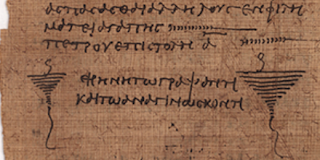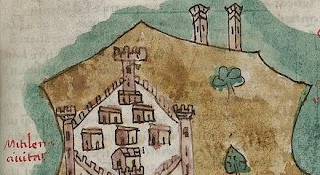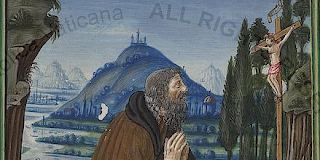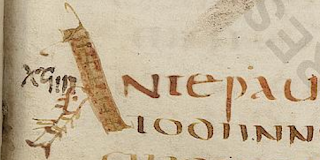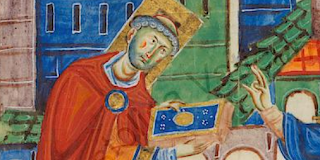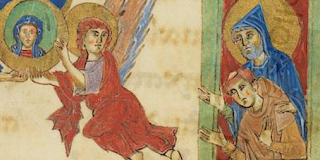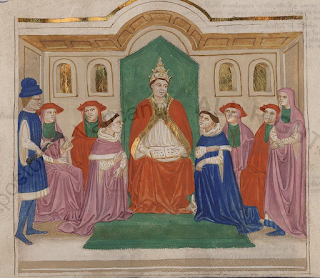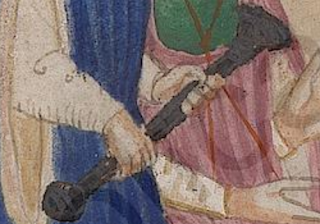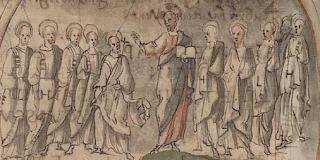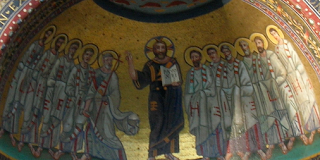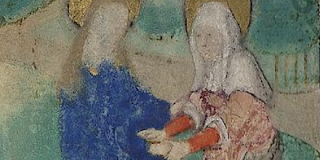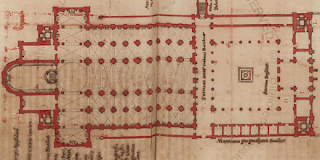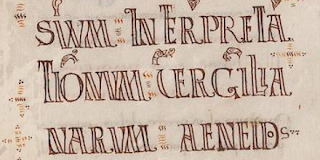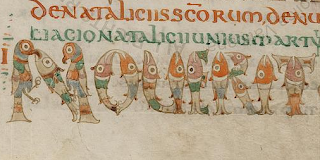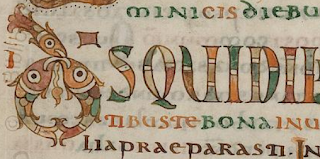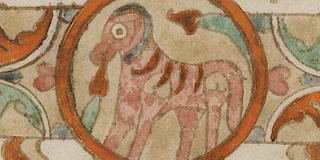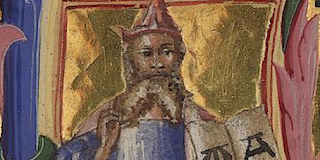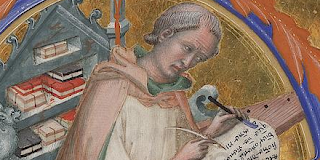Written in Greek, most are little codices, a few are rolls. Most of the ancient world's books have vanished, but the dry air of Egypt preserved just a few like these. The Biblioteca Apostolica Vaticana now holds several Bodmer Papyri of importance to Christianity.
One is an item known to scholarship as
 72, a 3rd- or 4th-century manuscript. Part of it, containing sections of epistles Peter 1 and 2, was donated to Pope Paul VI in 1969. [My thanks to Brent Nongbri of Sydney (his page on Academia.edu) for explaining this to me.] Its BAV shelfmark is Papiri Bodmer VIII. The leaves have been unbound and each is kept in a glass frame. Its age naturally makes it a matter of interest in the debate on my blog last year about the world's oldest book.
72, a 3rd- or 4th-century manuscript. Part of it, containing sections of epistles Peter 1 and 2, was donated to Pope Paul VI in 1969. [My thanks to Brent Nongbri of Sydney (his page on Academia.edu) for explaining this to me.] Its BAV shelfmark is Papiri Bodmer VIII. The leaves have been unbound and each is kept in a glass frame. Its age naturally makes it a matter of interest in the debate on my blog last year about the world's oldest book.P72 is celebrated enough to have its own Wikipedia entry with links that you can follow up. It came online on January 25, the first of the Bodmer Papyi to appear and one of the latest 136 Digita Vaticana releases. The images are dissimilar from the other scans and may simply come from the BAV's photographic collection. Previously, only some black-and-white microfilm images of this papyrus were accessible online via CSNTM.
My strictly unofficial list of the 136 releases is below (the BAV makes no running announcements), and I will add more annotations to this list as I have time. The links below lead to a BAV catalog page. You then have to click on book logo at the top left to see the actual digitization.
- Arch.Cap.S.Pietro.G.36,
- Arch.Cap.S.Pietro.H.46,
- Arch.Cap.S.Pietro.I.15,
- Barb.lat.4072,
- Barb.lat.4073, Dante
- Barb.lat.4079,
- Barb.lat.4087,
- Barb.lat.4098,
- Barb.lat.4116,
- Barb.lat.4117,
- Barb.lat.4119,
- Barb.lat.7943, charters, I see a date 1624 on one
- Barb.or.143,
- Barb.or.157,
- Borgh.226, Novels of Justinian
- Cappon.298,
- Chig.L.VIII.293, Dante?, annotations to verse
- Ott.lat.3316,
- Pal.gr.140,
- Pal.lat.23,
- Pal.lat.47,
- Pal.lat.965,
- Pal.lat.972,
- Pal.lat.974,
- Pal.lat.975,
- Pal.lat.976,
- Pal.lat.978,
- Pal.lat.980,
- Pal.lat.1207,
- Pal.lat.1276,
- Pal.lat.1351,
- Pal.lat.1362.pt.A,
- Pal.lat.1362.pt.B,
- Pal.lat.1365,
- Pal.lat.1400,
- Pal.lat.1418,
- Pal.lat.1424,
- Pal.lat.1447,
- Pal.lat.1459,
- Pal.lat.1463,
- Pal.lat.1464,
- Pal.lat.1465,
- Pal.lat.1472,
- Pal.lat.1475,
- Pal.lat.1479,
- Pal.lat.1483,
- Pal.lat.1486,
- Pal.lat.1488,
- Pal.lat.1489,
- Pap.Bodmer.VIII, see above
- Ross.463, just a few fragments of a lost 14th-century codex of Dante's Divine Comedy
- Urb.lat.13,
- Urb.lat.31,
- Urb.lat.52,
- Urb.lat.59,
- Urb.lat.99,
- Urb.lat.119,
- Urb.lat.120,
- Urb.lat.242,
- Urb.lat.272,
- Urb.lat.306,
- Urb.lat.312,
- Urb.lat.315,
- Urb.lat.324,
- Urb.lat.325,
- Urb.lat.326,
- Urb.lat.338,
- Urb.lat.340,
- Urb.lat.342,
- Urb.lat.344,
- Urb.lat.350, Aeneid by Virgil, see Rome Reborn catalog where Anthony Grafton opines (I am not sure why) that "this is perhaps the most lavishly illustrated of all copies of Virgil in existence." Here's a detail:
- Urb.lat.357,
- Urb.lat.362,
- Urb.lat.363,
- Urb.lat.364,
- Urb.lat.369,
- Urb.lat.377,
- Urb.lat.379,
- Urb.lat.380,
- Urb.lat.382,
- Urb.lat.386,
- Urb.lat.390,
- Urb.lat.391,
- Urb.lat.392,
- Urb.lat.393,
- Urb.lat.394,
- Urb.lat.395,
- Urb.lat.398,
- Urb.lat.399,
- Urb.lat.403,
- Urb.lat.404, papal bulls
- Urb.lat.408,
- Urb.lat.409,
- Urb.lat.414,
- Urb.lat.415, De Rebus Gestis Alexandri Magni of Q. Curtius Rufus (Life of Alexandra the Great) with this bad-tempered child faun at fol. 1r
- Urb.lat.419,
- Urb.lat.422,
- Urb.lat.424,
- Urb.lat.431,
- Urb.lat.436,
- Urb.lat.437,
- Urb.lat.440,
- Urb.lat.441,
- Urb.lat.455,
- Urb.lat.456,
- Urb.lat.459, Liber insularum archipelagi by Cristoforo Buondelmonti, a book of maps and account of the author's adventurous exploration of the islands of the Aegean in 1415 or so. The illustrations suggest the nostalgic and obsessive love for the classical past, notes Anthony Grafton's Rome Reborn catalog. See the St Louis catalog too. Here is Mytilene on Lesbos (fol. XXXr), 600 years before the current refugee wave was arriving on the island:
- Urb.lat.464, Florentine History by Leonardo Bruni, best-selling 15th-century author. See the St Louis catalog and Grafton's Rome Reborn catalog.
- Urb.lat.469,
- Urb.lat.471,
- Urb.lat.475,
- Urb.lat.480,
- Urb.lat.481, homilies of Ephraem the Syrian, Latin translation, and here he is:
- Urb.lat.482,
- Urb.lat.484,
- Urb.lat.486,
- Urb.lat.520,
- Urb.lat.682, Dante
- Vat.ar.2016,
- Vat.gr.2556,
- Vat.lat.28,
- Vat.lat.41,
- Vat.lat.48,
- Vat.lat.84, The Psalter of Nonantola (10th to 11th century), Beuron number 368
- Vat.lat.120, Gospels, with illumination by an artist of the Fécamp Bible
- Vat.lat.144,
- Vat.lat.242,
- Vat.lat.270,
- Vat.lat.389,
- Vat.lat.409,
- Vat.lat.459, Augustine, Confessions, 11th-12th century
- Vat.lat.471,
- Vat.lat.521, Humbert on Augustine, incipit "Viris religiosis non modicum ... "
- Vat.lat.4780, Dante
- Vat.lat.5465, an 8th or 9th-century Latin Gospel Book in uncial with fine Eusebian canon tables. The codicologist Michael Gorman (whose key article on the topic I have featured previously on this blog here and here) says it is one of a set of the southern Tuscan type, stating: "It seems to me that the abbey at Monte Amiata is a very probable origin for some of these manuscripts. We know of few likely alternatives." I have blogged on Monte Amiata here as well in case you are curious about the place itself. On canon tables, note Martin Wallraff's plans for an edition.
- Vat.lat.5691, Cardinal Cesare Baronio, 1538-1607, Annales ecclesiastici, vol. VIII
- Vat.lat.5758, Sermons of Augustine in one of the oldest manuscripts, made at Bobbio, Italy in the 6th or 7th century, see the catalog entry at St Louis. Lowe, CLA 1 36, TM 66131. It is marked on the front (p. 1) as coming from the book chest of Abbot Bobolenus. This pre-Carolingian homiliary is one of the sources of W. M. Lindsay's Notae Latinae covering abbreviations in the early minuscule period such as "ff kk" for "beloved brothers. Martin Hellmann is studying these. The codex also has some small but interesting initials, like this A on p. 95:
Gorman, Michael. “Manuscript Books at Monte Amiata in the Eleventh Century.” Scriptorium 56 (2002): 225–93: 268–71.
